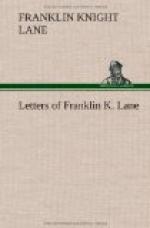In the course of the evening Mr. Charles Glover, President of the Riggs National Bank, told me this bit of history. That when he was a boy, in the bank one day Mr. Cochran came to him and handed him two warrants upon the United States Treasury, one for $1,400,000. and the other for $5,800,000. He said, “Put those in the safe.” Mr. Glover did so, and they remained there for a week, when they were sent to New York. Mr., Glover said “These warrants were the payment of Russia for the Territory of Alaska. Why were there two warrants? I never knew until some years later, when I learned the story from Senator Dawes, who said that prior to the war, there had been some negotiations between the United States and Russia for the purchase of Alaska, and the price of $1,400,000. was agreed upon. In fact this was the amount that Russia asked for this great territory, which was regarded as nothing more than a barren field of ice.
“During the war the matter lay dormant. We had more territory than we could take care of. When England, however, began to manifest her friendly disposition toward the Confederacy, and we learned from Europe that England and France were carrying on negotiations for the recognition of the Southern States, and possibly of some manifestation by their fleets against the blockade which we had instituted, (and which they claimed was not effective and merely a paper blockade), we looked about for a friend, and Russia was the only European country upon whose friendship we could rely. Thereupon Secretary Seward secured from Russia a demonstration, in American ports, of Russian friendship. Her ships of war sailed to both of our coasts, the Atlantic and Pacific, with the understanding that the expense of this demonstration should be met by the United States, out of the contingent fund. It was to be a secret matter. “The war came to a close, and immediately thereafter Lincoln was assassinated and the administration changed. It was no longer possible to pay for this demonstration, secretly, under the excuse of war, but a way was found for paying Russia through the purchase of Alaska. The warrant for $1,400,000. was the warrant for the purchase of Alaska, the warrant for $5,800,000. was for Russia’s expenses in her naval demonstration in our behalf, but history only knows the fact that the United States paid $7,200,000. for this territory, which is now demonstrated to be one of the richest portions of the earth in mineral deposits.”
TO HON. WOODROW WILSON
THE WHITE HOUSE
Washington, November 3, 1917
My dear Mr. President,—On April 7, 1917, the Council of National Defense adopted a report, submitted by the Chairman of the Executive Committee on Labor of the Advisory Commission of the Council, urging that no change in existing standards be made during the war, by either employers or employees, except with the approval of the Council of National Defense. ...




